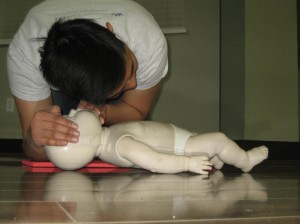A key component to standard first aid training, which we now offer in Calgary) is for participants to have a strong working knowledge and understanding of how to do CPR on a adult, child and infant victims coupled with the use of a automated external defibrillator (AED). In order to complete the course candidates will have to include components taught earlier in the course including implementing a AED, assessing the scene and wearing protective equipment as Single Person Rescuer. In the course candidates will have to demonstrate one-rescuer adult, child and infant cardiopulmonary resuscitation (CPR) on a manikin, include AED use and be able to deal with complications such as vomiting and regurgitating victims. The CPR standards presented in this page is the most recent CPR standards as provided by the major first aid and CPR providers. The material posted here is for information purposes only.
To successfully complete the standard first aid course candidates must show the following skills when doing CPR and using a AED:
- Single Person Rescuer must assess the scene for hazards.
- Single Person Rescuer must determine, if possible, the cause of injury or emergency.
- Prior to tending to a infant or child, rescuers must receive consent from parents or caregivers. If no parents or caregivers are present consent is implied.
Standard first aid includes infant CPR training. - Rescuers must check for the responsiveness of the victim (in this case it is unresponsive).
- Participants must position the victim in appropriate position and adapting this positioning if a spinal injury is present or if it will seriously aggravate another injury.
- Participants will open the airway of the victim and look, listen and feel for normal or abnormal breathing for 5 seconds.
- Rescuers will notify EMS through the most effective means necessary (using a bystander whenever available) and acquire a AED if possible.
- If breathing is absent or abnormal candidates will perform 30 chest compressions to 2 rescue breaths (using protective equipment if available) until the AED or EMS arrives, the victim becomes responsive or if the rescuer is too tired to continue.
- If signs of life are present, the rescuer must reassess ABC’s and treat appropriately.
The notes mentioned above are a brief outline of CPR techniques for one rescuer adult, infant and child CPR. Doing CPR effectively is significantly more complicated than the notes provide. To learn to do effective and up-to-date CPR take a standard first aid course near you through a credible provider.
